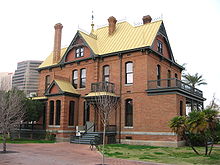- Rosson House
-
Dr. Roland Lee Rosson House
 Rosson House
Rosson HouseLocation: 139 North 6th Street, Phoenix, AZ Coordinates: 33°27′0.72″N 112°3′57.6″W / 33.4502°N 112.066°WCoordinates: 33°27′0.72″N 112°3′57.6″W / 33.4502°N 112.066°W Built: 1892 Architect: Unknown Architectural style: Stick-Eastlake Queen Anne Victorian Governing body: Private NRHP Reference#: 71000112 [1] Added to NRHP: June 3, 1971 The Rosson House was built in 1895 and still sits in its original foundation in downtown Phoenix’s Heritage Square. Originally named for Dr. Roland Lee Rosson and his wife Flora Murry, this house changed hands numerous times before finally being purchased by the city and restored very accurately to its original condition. [2] It now serves as a historic house museum. [3]
Contents
Architecture
This house is commonly agreed to be of the Stick-Eastlake Queen Anne Style Victorian architecture. It was designed by prominent San Francisco architect A.P Petit. This was the last house Petit designed but he died before its completion. Near exact floor plans and blue prints of this house can be found in literature published before Petit’s design of the house, causing controversy that perhaps this house is not as unique as originally thought. The architecture displays numerous attributes contributed from different cultures, such as an Asian moon gate, Italianate hooded windows, and a French octagonal tower. [2]
History
This beautiful small mansion was built for Dr. Roland Lee Rosson and his wife Flora Murry. Dr. Rosson had come to the very early Phoenix by at least 1880 as a youthful 28 year-old doctor and surgeon, though in a town as small as Phoenix was then there would have been very few surgeries to perform. So, by 1892 Rosson had embarked on a political career and was the county treasurer and "ex-officio tax collector". The date for the construction of the house is debatable as the Rosson House website states it was built in 1895, but the 1892 city directory clearly shows the house was already standing with the words that Rosson "resides [at the] Tonto corner [of] Monroe", Tonto was the old name of 6th Street, and Monroe intersects it there. Purportedly, shortly after its completion Dr. Rosson was elected mayor of Phoenix and that his grand house was thought to have greatly influenced his victory.
The Rosson house also had such modern accommodations as “the electric light”, hot and cold running water, and indoor (upstairs) bathroom, and a telephone. The other Victorian mansions on Monroe were similarly equipped early on, as by 1892 Phoenix boasted electrical plants, running-water, a gas system and 2 competing telephone systems. The Phoenix street-car line ran down Monroe before turning north on Seventh Street, so the Rosson and other Monroe street residents had only to walk out to board it.
Whitelaw Reid rented this house for two winters from the Rossons when his doctors informed him that the dry climate could help with his respiratory problems. Whitelaw Reid's pen and ink set was donated to the Rosson house after his death and can be found on display. It is from Whitelaw Reid’s letters and correspondence about the house that so much about its history is known. Without these letters it would have been difficult to restore the house with such accuracy. It should be added that a subsequent owner had built on a small but nice-looking wooden room adjacent to the second story of the octagonal tower, this addition was removed in the early stages of the restoration. The Rosson House had gone through phases of being a mansion, a rented house, a boarding house, and than a "flop-house" before it was bought by the city of Phoenix for restoration.[2]
Other brick landmarks
The Rosson House is an early example, but not first, of a house in Phoenix constructed of fired brick and wood instead of adobe bricks. At least one brick-making factory was established locally before. Some fine examples of early brick/block houses that predated the Rosson House include the mansion built in 1887 for John T. Dennis at 242 E. Monroe and its neighbor mansion at 230 E. Monroe built for M. Jacobs. The John T. Dennis mansion was beautiful, as the Rosson House is, however when the pioneer Mr. Dennis decided to move elsewhere he opted to rent his mansion out repeatedly, and with his death the eventual consequences were of it being torn down in the 1950's. Three blocks down Monroe the Rosson house still stands. Additionally there was the large house built for Columbus Gray in 1890, the J.Y.T. Smith home at 5th St. and Adams reportedly dates from 1892.
A number of smaller homes were built outside the city limits in the 1880's by J.J. Welty, and made out of poured concrete blocks made to look like hewn-stone. There is also the mansion built by John T. Dennis' neighbor Clark Churchill which in turn became the first building of Phoenix Union High School. Additionally almost all of the early hotels of Phoenix were made out of locally produced red bricks.
Access
The city of Phoenix operates the restored Rosson House as a historic house museum and offers public tours. [4]
References
- ^ "National Register Information System". National Register of Historic Places. National Park Service. 2007-01-23. http://nrhp.focus.nps.gov/natreg/docs/All_Data.html.
- ^ a b c http://www.rossonhousemuseum.org/
- ^ http://www.rossonhousemuseum.org/about/
- ^ http://www.rossonhousemuseum.org/tours/
- [1.] nr.nps.gov[dead link]
- [2.] Phoenix City Directory For The Year 1892
- [3.] Vanishing Phoenix (c) 2010 by Robert Melikian
- [4.] A Legal History Of Maricopa County (c) 2007 by Stan Watts
External links
Categories:- NRHP articles with dead external links
- Houses completed in 1895
- Historic house museums in Arizona
- Residential buildings in Phoenix, Arizona
- Museums in Phoenix, Arizona
- Houses on the National Register of Historic Places in Arizona
- Queen Anne architecture in the United States
- Victorian architecture in Arizona
Wikimedia Foundation. 2010.

